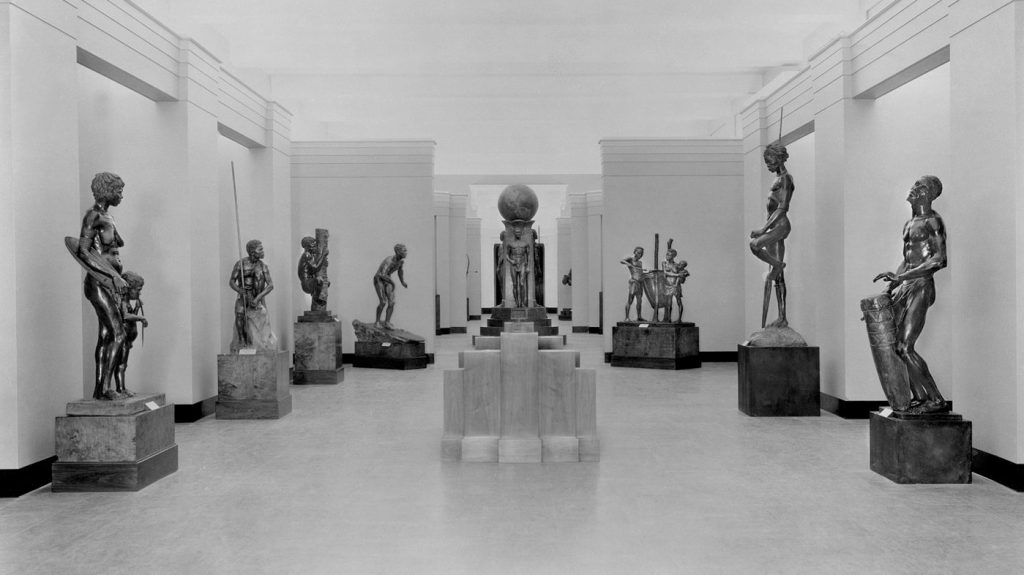Many people, including myself, are re-evaluating their views on race and racism. It’s not easy to look at yourself and your actions and realize that even if you have good intentions, there’s some bias in every decision you make.
So what happens when a world-famous museum puts a lens up to its past and doesn’t like what they see? If it’s the Field Museum in Chicago, they make an entire exhibit about the subject.
Plenty of people visit The Field Museum to see the dinosaurs, including Sue, the T-Rex.
Other people might be more interested in learning about two of the other infamous residents of the Field, the Tsavo Lions.
While seeing all of these things were great, there was one exhibit that we’re still talking about for years after our visit. It’s a fascinating retrospective on how people’s opinions can change towards a topic such as race in the timespan of a lifetime.
We were walking along a back hallway of the museum when we came across an exhibit featuring bronze statues. We stopped by, mainly because there were benches and we wanted to sit, but when we started reading the descriptions, we were transfixed.
LOOKING AT OURSELVES: RETHINKING THE SCULPTURES OF MALVINA HOFFMAN
Here’s a description of the exhibit from the Field Museum’s Website:
In the early 1930s, the Field Museum commissioned sculptor Malvina Hoffman to create bronze sculptures for an exhibition called The Races of Mankind. Hoffman, who trained under Auguste Rodin, traveled to many parts of the world for an up-close look at the “racial types” her sculptures were meant to portray.
By the time the exhibition was deinstalled more than 30 years later, more than 10 million people had seen it—as well as its misguided message that human physical differences could be categorized into distinct “races.”
Today, 50 of Hoffman’s sculptures are back on display—with a new narrative—in Looking at Ourselves: Rethinking the Sculptures of Malvina Hoffman. This exhibition closely examines the nuance and beauty that defines the person and inspiration behind each sculpture.
Looking at Ourselves takes a hard look at the 1933 exhibition. More than 80 years later, our cultural and scientific notions of race have changed—but the consequences of racial ideologies persist.
This exhibit was a fascinating look back at how, only 85 years ago, it was the educated opinion that people of different races acted differently from one another because of some difference in their make up. There are no pulled punches when talking of the exhibit that was on display for more than three decades, where sculptures were only identified by their area of origin, such as “Pueblo Woman.”
Looking at the sculptures today, it is evident that the sculptor, Malvina Hoffman, viewed these people as individuals. Her detail in crafting the over 100 sculptures for the exhibit is amazing. These are pieces of art as well as historical documents.
Many of the sculptures are busts of people from all over the world.
There are also several full-body sculptures, as well: If you had any doubts about how the curators felt, they put everything right on the table, literally. This interactive exhibit tells the difference in how the sculptures were presented in the 1930s vs. how we think of them today.It was somewhat shocking to see someone point out the blatant racism of our past and how educated people found scientific explanations to justify their beliefs and actions. The museum didn’t try to whitewash history since the original exhibit was funded by Stanley Field, the president of the museum.
I was sad to see that for the 30 minutes or so that we wandered around, reading the plaques, looking at the sculptures and pondering how far we’d come (and how much further we have to go) that we were the ONLY ONES who were in the entire exhibit. I mean, we stumbled upon it by wandering around the museum but it was a totally captivating look at everything from race, science, museum curation and art. I hope that more people get to see this exhibit since it does the one thing that museums are genuinely made for, it makes you think and examine your own actions.
In light of what’s happening today, this exhibit is more timely than ever. When we visited. Maybe the exhibit was empty because people weren’t ready to read what the curators had to say. But things are changing and now people are more prepared to examine their own biases.
What will people think in 80 years when they look at us and what we believe about race? Will they shake their heads and say, “How could they be so ignorant?” I’m more hopeful that it will not be the case than I’ve been before.
I have hope from the sculptor, who was the only one who met all of these people. Three decades after the museum put her art on display, she seemed to understand that all of these people were individuals, not examples of races to be separated from each other.
Want to comment on this post? Great! Read this first to help ensure it gets approved.
Want to sponsor a post, write something for Your Mileage May Vary, or put ads on our site? Click here for more info.
Like this post? Please share it! We have plenty more just like it and would love it if you decided to hang around and sign up to get emailed notifications of when we post.
Whether you’ve read our articles before or this is the first time you’re stopping by, we’re really glad you’re here and hope you come back to visit again!
This post first appeared on Your Mileage May Vary
Cover Photo from the Field Museum Website
Join our mailing list to receive the latest news and updates from our team.

